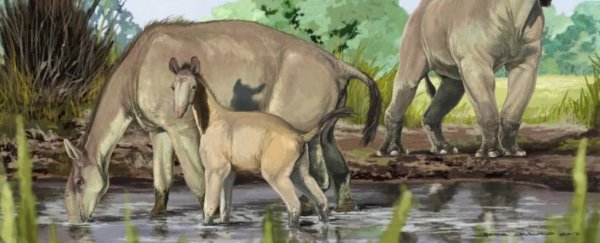Its nose, unlike that of most mammals, was right between the eyes, like an elephant's trunk. It weighed about as much as a horse. Its neck is long, leading scientists to believe that this strange creature discovered almost two centuries ago in South America could be an oversized llama.
But Macrauchenia patachonica is neither a llama nor a horse, nor an elephant, a new analysis of its fossils shows.
What exactly this creature was puzzled scientists, including the father of evolution, Charles Darwin. Its origin and what happened to its species had largely remained a mystery - until now.
Scientists from the University of Potsdam in Germany and the American Museum of Natural History analysed mitochondrial DNA extracted from a fossil found in a cave in southern Chile.
Here's what they discovered: Macrauchenia is a distant relative of horses, rhinos and tapirs, and together, they're part of a group called Perissodactyla.
The animal's lineage and that of modern perissodactyls, which includes zebras and rhinos, split about 66 million years ago, around the time of the dinosaurs' extinction, and hadn't had a common ancestor since then.
"We were able to, for the first time using DNA evidence, place a very weird mammal in its proper evolutionary context," Ross MacPhee, a curator for the American Museum of Natural History and one of the leaders of the study published this week, told The Washington Post.
"Prior to this study, that was not clear."
In studying ancient DNA, scientists usually rely on genetic material from a species' close evolutionary relatives, according to the American Museum of Natural History.
But because Macrauchenia doesn't have any close living relatives, scientists had to find another way to reconstruct its genetic makeup, the lead author, Mick Westbury of the University of Potsdam, said in a news release.
Scientists used the DNA of a number of living species as reference points and eventually recovered about 80 percent of Macrauchenia's mitochondrial genome.
A related 2015 study analysed protein from the bones of Macrauchenia and another strange creature that existed around the time, called Toxodon. Darwin first discovered the fossils of both animals in the 19th century.
The earlier study had much of the same findings and placed Macrauchenia and Toxodon under the Perissodactyla group.
But the most recent DNA analysis is more precise and allowed scientists to pinpoint when Macrauchenia separated from the evolutionary lineage that produced modern-day horses, rhinos and tapirs, MacPhee said.
"In science, it's always important to corroborate results, use different approaches, different molecules," MacPhee said.
The group was unable to conduct the same DNA analysis on Toxodon. But MacPhee said he's optimistic considering the success with Macrauchenia.
The two were the last of the South American native ungulates, a highly diverse group of hoofed mammals that roamed the continent millions of years ago. Many of them disappeared 20,000 years ago, and Macrauchenia and Toxodon vanished about 10,000 years ago.
Darwin discovered the first Macrauchenia and Toxodon fossils in 1834 during his travels to South America. He found Macrauchenia on the southern coast of Argentina.
And while in Uruguay, he heard about a farmer who dug up "some extremely strange beast" and went to check it out, MacPhee said.
That animal was Toxodon, which was about twice the size of Macrauchenia. Darwin described it as the "strangest animal ever discovered".
It had curved teeth, similar to that of a rodent. It was about the same size as a rhino, had very short legs, a huge body and an enormous skull, MacPhee said.
"He was really amazed by the beast, which is something to underline," MacPhee said of Darwin. "He had never seen anything like them. Nobody had ever described anything like them."
2017 © The Washington Post
This article was originally published by The Washington Post.
